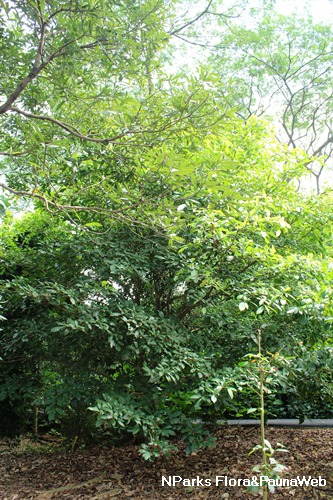
Back
Baccaurea motleyana (Müll.Arg.) Müll.Arg.
| Family Name: | Phyllanthaceae |
| Common Name: | Rambai, Common Rambai, Jelintik, Buah Jentik, Asam Lambun, Tampoi, 多脉木奶果 |
Baccaurea motleyana, also known as Rambai, is a tree which is critically endangered in Singapore. Flowers occur in long clusters on the branches or trunk. Fruit is almost round and turn brownish-yellow coloured when ripe, without splitting. Each seed is covered with an edible, sweet tasting aril which is translucent white to purple.
Name
Classifications and Characteristics
| Plant Division | Angiosperms (Flowering Seed Plants) (Dicotyledon) |
|---|---|
| Plant Growth Form | Tree (Medium (16m-30m)) |
| Lifespan (in Singapore) | Perennial |
| Mode of Nutrition | Autotrophic |
| Plant Shape | Irregular |
| Maximum Height | 15 m to 25 m |
| Tree or Palm – Trunk Diameter | 40 cm |
Biogeography
| Native Distribution | Peninsular Malaysia, Singapore, Sumatra and Borneo. |
|---|---|
| Native Habitat | Terrestrial (Primary Rainforest, Secondary Rainforest) |
| Preferred Climate Zone | Tropical |
| Local Conservation Status | Native to Singapore (Critically Endangered (CR)) |
Description and Ethnobotany
| Growth Form | It is a tree, 15 – 25 m tall, and has a diameter of 40 cm. |
|---|---|
| Crown | Crown is low, round and bushy. |
| Foliage | Its alternate, long-stalked leaves have leathery leaf blades that are elliptic to obovate, 13.5-37 cm long and 5-15 cm wide. |
| Flowers | Its tiny, yellowish-green flowers are fragrant, borne on single flowering shoot or up to five in a bunch. |
| Fruit | Its round, 3-seeded fruits are buff-coloured, 2.2-4.5 cm wide. Each seed is covered by an edible, translucent white to purplish aril. |
| Others - Plant Morphology | Prefer alluvial soils, budding is also possible. 7 - 9 m apart is best for the trees. Germinations, from seeds, happen in a matter of days. |
| Habitat | It grows in lowland forests and hills up to 900 m altitude. |
| Associated Fauna | Its flowers are pollinated by insects. The fruits are eaten by mammals. |
| Cultivation | It can be propagated by seed. |
| Etymology | Latin bacca, berry; Latin aurea, golden referring to the golden colour of the berries; Latin motleyana, commemorating J. D. Motley (–1859), an engineer and plant collector based mainly in Borneo. |
| Ethnobotanical Uses | Edible Plant Parts : Edible Fruits Food (Fruit or Vegetable): The fruit is edible. |
Landscaping Features
| Landscaping | It is suitable for gardens, parks or roadsides. |
|---|---|
| Desirable Plant Features | Ornamental Fruits, Fragrant (Flowers) |
| Landscape Uses | General, Suitable for Roadsides, Parks & Gardens, Small Gardens |
| Thematic Landscaping | Economic Garden |
Fauna, Pollination and Dispersal
| Pollination Method(s) | Biotic (Fauna) |
|---|---|
| Seed or Spore Dispersal | Biotic (Fauna) |
Plant Care and Propagation
| Light Preference | Full Sun |
|---|---|
| Water Preference | Moderate Water |
| Plant Growth Rate | Moderate |
| Rootzone Tolerance | Fertile Loamy Soils, Well-Drained Soils, Waterlogged Soils (Drains Site) |
| Maintenance Requirements | Moderate |
| Propagation Method | Seed |
Foliar
| Foliage Retention | Evergreen |
|---|---|
| Mature Foliage Colour(s) | Green |
| Mature Foliage Texture(s) | Leathery |
| Foliar Type | Simple / Unifoliate |
| Foliar Arrangement Along Stem | Alternate |
| Foliar Attachment to Stem | Petiolate |
| Foliar Shape(s) | Non-Palm Foliage (Obovate, Elliptical) |
| Foliar Venation | Pinnate / Net |
| Foliar Margin | Entire |
| Leaf Area Index (LAI) for Green Plot Ratio | 4.0 (Tree - Dense Canopy) |
Floral (Angiosperm)
| Flower & Plant Sexuality | Unisexual Flowers , Dioecious |
| Flower Colour(s) | Yellow / Golden, Cream / Off-White |
|---|
| Flower Grouping | Cluster / Inflorescence |
| Flower Location | Cauliflorous |
Fruit, Seed and Spore
| Mature Fruit Colour(s) | Cream / Off-White, Brown |
|---|---|
| Fruit Classification | Simple Fruit |
| Fruit Type | Fleshy Fruit , Non-Accessory Fruit |
Image Repository
Others
| Master ID | 1446 |
|---|---|
| Species ID | 2739 |
| Flora Disclaimer | The information in this website has been compiled from reliable sources, such as reference works on medicinal plants. It is not a substitute for medical advice or treatment and NParks does not purport to provide any medical advice. Readers should always consult his/her physician before using or consuming a plant for medicinal purposes. |




_lowres.jpg)
_lowres.jpg)


_lowres.jpg)

